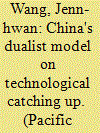| Srl | Item |
| 1 |
ID:
074432


|
|
|
|
|
| Publication |
2006.
|
| Summary/Abstract |
The central question of this paper is whether China can go beyond simple technological transfer and toward innovation in this age of globalization. By adopting an institutionalist perspective, this paper argues that China has developed a dualist model during its economic transitional period in which the foreign sector has been isolated from domestic firms, while the domestic industrial sectors have also failed to develop organic linkages among themselves to facilitate technological learning and generate innovation. This paper discusses four major institutional arrangements that deeply influence China's technological development - the institutional logic of economic reform, the state's industrial policy, the financial system and the industrial structure. It suggests that, owing to these institutional elements, China has neither developed economies of scale, as compared with the South Korean case, nor has it built up a network-type of economy similar to its Taiwanese counterpart in order to generate the mechanisms needed for technological innovation.
|
|
|
|
|
|
|
|
|
|
|
|
|
|
|
|
| 2 |
ID:
101100


|
|
|
|
|
| Publication |
2010.
|
| Summary/Abstract |
Studies on industrial clustering identify factors that nourish the clustering and thus aid in industrial development. We classify these as government incentives and economic fundamentals. Economic fundamentals, which we define as a set of essential factors conducive to the development of an industry cluster, may be the result of chance - for instance, geographical location and climate or may be a result of long term government policies such as affordable and abundant higher education. We examine the importance of government incentives relative to the economic fundamentals in the development of the software services industry in Thailand. Our survey of investors, both foreign and domestic, in the software services industry in Thailand, found that economic fundamentals were perceived as being more important than government incentives in influencing investment decisions. This raises important questions for government policy. For example, is money used for tax breaksand grants efficiently spent? Or, could the money be better invested in improving the quality of human resources and infrastructure? Based on the findings of this study, recommendations are proposed for government policy and directions for future research.
|
|
|
|
|
|
|
|
|
|
|
|
|
|
|
|
| 3 |
ID:
105057


|
|
|
| 4 |
ID:
183740


|
|
|
|
|
| Summary/Abstract |
The article presents differences in firm-level total factor productivity in the information technology (IT) service firms in India over the period 2000–2016. It is an attempt to study whether technological efforts contribute to productivity differences in the firms in conjunction with several other firm specific characteristics. Controlling for endogeneity in inputs, the estimation of productivity through semi-parametric techniques indicates considerable heterogeneity in productivity across firm types. Technological efforts of firms have a significant impact on the productivity of IT firms. Both embodied technology imports and in-house R&D contribute to higher productivity. While the Indian firms are observed to be more productive compared to their foreign counterparts, the technological efforts also differ due to ownership factors and that contributes to changes in productivity.
|
|
|
|
|
|
|
|
|
|
|
|
|
|
|
|